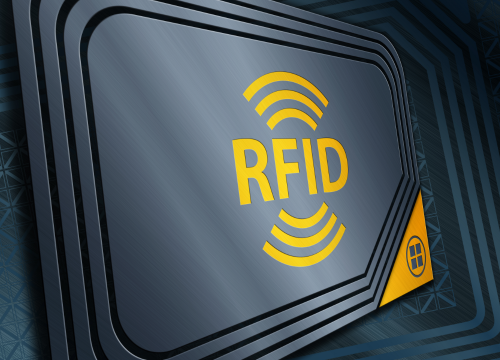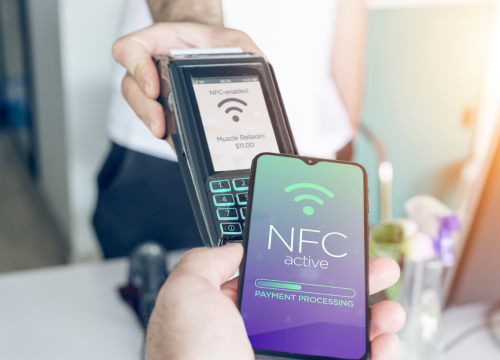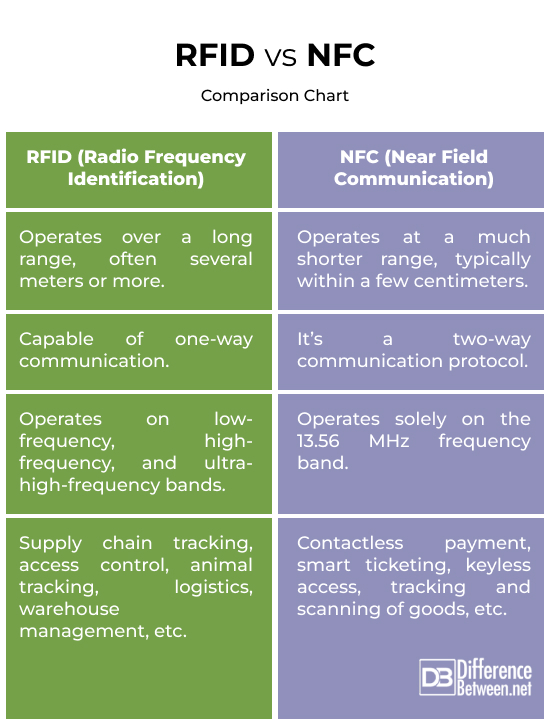Difference Between RFID and NFC
Imagine a world where everyday objects talk and seamlessly share information without needing a physical touch. This is where wireless communication technologies like RFID and NFC come to the picture. These technologies enable devices to communicate with each other.
RFID and NFC are based on the same principle; they use radio waves to transmit data wirelessly, often to identify, track, and share information.
Let’s delve deeper into how these technologies work and the differences between RFID and NFC.

What is RFID?
RFID, short for Radio Frequency Identification, is a technology that uses radio waves to identify and track objects, people, or animals. It’s a wireless communication technology that uses cards or tags to store data.
It consists of two main components: RFID tags and RFID readers.
RFID tags are small devices that contain information and can be attached to or embedded in objects. They have a unique identifier that can be read by an RFID reader.
RFID readers use radio waves to communicate with the RFID tags and retrieve information. They are commonly used for inventory management, inventory tracking, access control, contactless payment, and more.

What is NFC?
NFC, short for Near Field Communication, is a subset of RFID technology that enables communication between devices when they’re in close proximity, typically within a few centimeters. It’s a two-way communication protocol. NFC allows devices to send and receive data.
NFC technology is widely used in contactless payments. When you tap your phone on a terminal to pay at stores, you’re using NFC for payments.
Other common applications include:
- Quick and easy data transfer between devices.
- Access cards and keycards for secure entry to buildings or restricted areas.
- NFC tags store information that can be read by NFC-enabled devices.
Difference between RFID and NFC
Communication Range
While both technologies are based on the same working principle, the difference lies in the range. RFID is able to transmit information without needing direct contact or line-of-sight. It operates over a long range, often several meters or more.
NFC, on the contrary, operates at a much shorter range, typically within a few centimeters.
Two-Way Communication
RFID is a one-way communication system. The RFID reader reads information from the RFID tag, but the tag doesn’t send information back to the reader.
Unlike RFID, NFC is a two-way communication protocol that allows devices to send and receive data. It not only reads tags, but also transfers data between devices like smartphones and smartcards.
Frequency Bands
Depending on the application requirements, RFID operates on various frequency bands, including low-frequency (LF), high-frequency (HF), and ultra-high-frequency (UHF).
NFC solely operates on the 13.56 MHz frequency band, the same as HF RFID. This standardized frequency ensures compatibility among different NFC-enabled devices.
Application Areas
RFID technology is primarily used for identification and tracking purposes. It’s used in several other applications, such as inventory management, supply chain tracking, access control, animal tracking, logistics, document tracking, warehouse management, and more.
NFC is primarily used for contactless payments. Other applications include smart ticketing, keyless access, tracking and scanning of goods, inventory management, theft control, etc.
RFID vs. NFC: Comparison Chart

Summary
While both RFID and NFC share similarities, NFC is a subset of RFID technology designed for short-range communication. RFID, on the other hand, is a broader technology used for a variety of identification and tracking applications. Both technologies use radio waves to transmit data wirelessly.
RFID is increasingly becoming a cost-effective technology. This is in large part because Walmart and DoD incorporate RFID technology into their supply chains.
FAQs
Is RFID the same as NFC?
Both use radio waves for contactless communication, but they are not the same. NFC is a subset of RFID technology designed for short-range communication.
How do I know if my card is RFID or NFC?
You can look for the symbol. An antenna-like symbol with radio waves usually indicates RFID, while the NFC symbol has four intersecting waves.
Do credit cards use RFID or NFC?
Most modern credit cards use both RFID and NFC.
What is the difference between NFC and RFID inventory?
RFID inventory systems have longer ranges (up to 10 meters), while NFC inventory systems have shorter ranges (a few centimeters).
Do I need RFID blocking for my passport?
Modern passports use RFID chips for identification, but the data is encrypted and requires close proximity reading by authorized readers.
If you are concerned about privacy, you may choose to use an RFID-blocking passport holder or wallet to prevent potential unauthorized access to your passport’s information.
Is my key fob NFC or RFID?
Key fobs can use either RFID or NFC technology. Check for symbols on the key fob or refer to the manufacturer’s information. Newer fobs likely use NFC technology.
- Difference Between Caucus and Primary - June 18, 2024
- Difference Between PPO and POS - May 30, 2024
- Difference Between RFID and NFC - May 28, 2024
Search DifferenceBetween.net :
References :
[0]Finkenzeller, Klaus. RFID Handbook: Fundamentals and Applications in Contactless Smart Cards, Radio Frequency Identification and Near-Field Communication. John Wiley & Sons, 2010.
[1]Finkenzeller, Klaus. RFID Handbook: Fundamentals and Applications in Contactless Smart Cards, Radio Frequency Identification and Near-Field Communication. John Wiley & Sons, 2010.
[2]Ahson, Syed A. and Mohammad Ilyas. RFID Handbook: Applications, Technology, Security, and Privacy. CRC Press, 2017.
[3]Hunt, V. Daniel, et al. RFID: A Guide to Radio Frequency Identification. John Wiley & Sons, 2007.
[4]Image credit: https://www.canva.com/photos/MAEEJ1vU154-contactles-payment-with-mobile-phone-nfc-technology/
[5]Image credit: https://www.canva.com/photos/MAED5VasoxM-rfid-tag/
